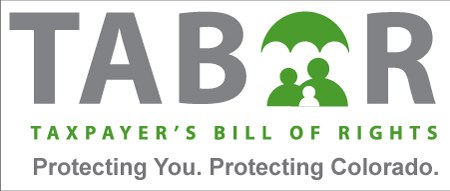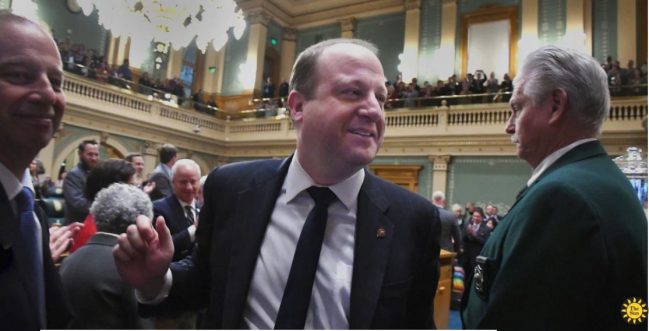(The money actually comes from TABOR reserves.)

A blackhawk helicopter carrying U.S. Army Lt. Gen. Todd Semonite flies over Denver toward the Colorado Convention Center. April 14, 2020. (Kevin J. Beaty/Denverite)

A blackhawk helicopter carrying U.S. Army Lt. Gen. Todd Semonite flies over Denver toward the Colorado Convention Center. April 14, 2020. (Kevin J. Beaty/Denverite)
The impact of the coronavirus pandemic on the $30 billion-plus state budget begins to take shape this week as lawmakers consider massive spending cuts.
How much tax revenue Colorado will lose to the paralyzed economy remains uncertain, but the governor’s budget office is projecting $3 billion in lost revenue for the current fiscal year and the next.
The General Assembly’s budget writers on Monday will start reviewing recommendations from legislative analysts for potential spending cuts across all government agencies. The documents are expected to include scenarios for slashing budgets as much as 20% and force legislators to make hard choices that will impact most Colorado families, according to drafts reviewed by The Colorado Sun.
April 7, 2020 by Dan Mitchell
As explained in this short video, a spending cap limits how fast a government’s budget can grow each year.
That’s a very sensible approach, sort of like having a speed limit in a school zone, and even left-leaning international bureaucracies have concluded it’s the best fiscal rule.
That being said, not all spending caps are created equal. A fiscal rule that allows continuous increases in the burden of government spending is akin to an excessive speed limit on the road in front of an elementary school.
is akin to an excessive speed limit on the road in front of an elementary school.
At a minimum, a spending cap should keep the spending burden constant (relative to the economy’s productive sector). Even better, a spending cap should fulfill the Golden Rule of fiscal policy by slowly but surely reducing the size of government.
Let’s learn from a real-world example.
Ben Wilterdink, a Visiting Fellow with the Alaska Policy Forum, explains for readers of the Peninsula Clarion that the state has a spending cap, but one that is set too high.
Alaska is in the midst of a perfect fiscal storm. …Even before the present crisis, our state faced large budget deficits and tough decisions about how to make ends meet. …That’s why adopting a functional limit on the growth in state spending is essential for long-term economic success.
…a functional limit in the growth of state spending decreases the temptation to dramatically increase spending when economic times are good, creating new budget expectations that are difficult to maintain during inevitable economic downturns… Technically, Alaska already has a constitutional spending cap in place, but the formula used renders it basically meaningless. …While Alaskans can’t retroactively adopt a meaningful spending limit, we can ensure that those economic benefits are captured going forward.
So why is a spending cap now an important issue?
“Truth and reason in ballot language!”
April, 2020
The Taxpayer’s Bill of Rights includes good government provisions that improve election procedures.
There was a time when Colorado elected officials could push for passage of a bond, or for new taxes, but bury the cost very deep into the explanation on the ballot, in hopes that many voters might not notice the magnitude of the tax.
The ballot language would promise all kinds of wonderful outcomes. Not only would the new revenues for the government solve the problem in perpetuity, but it would bring world peace and even make the voter more handsome! Then, near the end in the midst of a lot of other promises, would come the information that the cost to the taxpayer would be very, very high.
The Taxpayer’s Bill of Rights stopped that sort of game playing. Now, the government must put the cost right up front. It has no option but to state how much the new tax will weigh annually on the taxpayer. For a new bond, the ballot measure must state at the very beginning how much the total new debt will be and what that means for the total repayment cost. Only then may the government (“district”) present its reasons for the new taxes.
Another game that the Taxpayer’s Bill of Rights anticipated and which it explicitly prohibits is a government underestimating a revenue number. If the new taxes exceed the estimate, the entirety of the overage must be refunded the next year and the rate adjusted downward.
Colorado constitution (Article X, Section 20), paragraph 3(c) states: “Ballot titles shall begin, ‘SHALL (DISTRICT) TAXES BE INCREASED ____ ANNUALLY?’ (or) ‘SHALL (DISTRICT) DEBT BE INCREASED (principal amount) WITH A REPAYMENT COST OF (maximum..)’.” Earlier in the same paragraph is the requirement that “if a tax increase exceeds any estimate… for the same fiscal year, the tax increase is thereafter reduced up to 100% in proportion to the …excess, and the combined excess revenue refunded….”
The paragraph was carefully crafted as a good government improvement, with TABOR protecting the taxpayer in ways beyond just voting on tax rates.

…While more than half of states currently have some form of tax and expenditure limit, the most effective is Colorado’s Taxpayer Bill of Rights (TABOR), which constitutionally limits spending growth to the rate of inflation plus estimated population growth. The stable budget and tax climate created by TABOR has served Coloradans remarkably well. Over the past decade, Colorado’s gross state product (GSP) has grown by 45.5%, personal income has grown by 59.5%, and non-farm payroll employment has grown by 15.8%.
By comparison, during the same time period, Alaska’s GSP growth was 0%, personal income growth was 33.5%, and non-farm payroll employment growth was 0.3%.
But it’s not just Colorado that has benefited from a functional tax and expenditure limit. Nationwide, states with tax and expenditure limits have outperformed states without them in GSP growth, personal income growth, and employment growth…
…Once the COVID-19 crisis subsides, the federal government should wholeheartedly work toward a reduction in both federal spending and the national debt. There are many pro-taxpayer fiscal rules to choose from, including the Taxpayer Bill of Rights (TABOR) in Colorado, or a meaningful balanced budget amendment, like the one Indiana voters overwhelmingly inserted into their state constitution in 2018….

Colorado Gov. Jared Polis greets the crowd as he walks to the podium to deliver his second State of the State address at the state Capitol on Jan. 9, 2020 in Denver. (Kathryn Scott, Special to The Colorado Sun)
After years of groundwork, 2020 was supposed to be the time for Colorado tax reform.
Democratic Gov. Jared Polis kicked off his second year in office by doubling down on his pledge to eliminate special interest tax breaks to fund broad tax cuts. A legislative study group came into the session with an agenda of its own. And the state auditor’s office in January released a damning evaluation of one of the state’s most expansive — and controversial — tax breaks, the Colorado enterprise zone program.
Two months later, the tax overhaul effort is suddenly in limbo, like most everything else. The coronavirus has uprooted the legislative session, halting deliberations indefinitely. And even if lawmakers return to their duties, it’s not clear that a tax code rewrite will be a priority when the legislature reboots.
“Right now, nobody knows what’s going to happen,” said Rep. Adrienne Benavidez, the Commerce City Democrat who chaired the interim study committee.